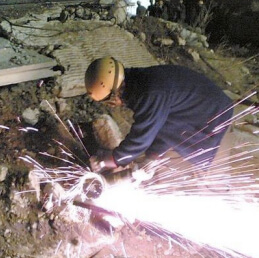CHALLENGE:
To create authentic US&R live immersive training scenarios that demonstrate the realities of disaster rescues with an instructive experience that mentally and physically challenges task forces.
BENEFIT:
US&R is a “multi-hazard” discipline and considered one of the most complex and difficult activities emergency responders can engage in. SensoryCo smoke systems and scent generators can be excellent instructional tools placed in US&R live immersive training scenarios to prepare task force teams for field operations as well as give them a glimpse of how to act by procedures when faced with frenzied environments.
When Disaster Strikes
Search and rescue teams aid people who are in distress or imminent danger with the goal to rescue the greatest number of people in the shortest amount of time while mitigating risks to both victims and task personnel. Rescue operations respond to catastrophes that require hazards of this nature to be handled by well-trained experts that are prepared to perform at their full potential while working under adversity, high stress and volatile conditions. US&R live immersive training scenarios have become extremely critical and highly specialized simulated instructional environments that replicate an actual disaster, often utilizing large Hollywood styled production sets.
Urban search and rescue is considered a “multi-hazard” discipline, as it may be needed for a variety of emergencies or disasters, including earthquakes, hurricanes, typhoons, storms and tornadoes, floods, dam failures, technological accidents, terrorist activities, and hazardous materials releases. The events may be slow in developing, as in the case of hurricanes, or sudden, as in the case of earthquakes. Urban Search and Rescue or Emergency Services Task Force is comprised of teams of individuals firefighters, engineers (U.S. Army Corps of Engineers) medical professionals, canine/handler teams and emergency managers with highly specialized training in urban search and rescue environments, and which serve as a resource for disaster response at local, state, federal, and international levels.
(source: Federal Emergency Management Agency)
What Does Disaster Feel Like?
 Following the devastation, urban search and rescue teams must be prepared to save lives and stabilize the environment. Emergency incidents may involve rescuing survivors of confined space, mass transportation incidents, climbing, industrial machinery accidents as well as rescuing victims from floods, swift-water, high-rise fire incidents and cave-ins. Creating comprehensive US&R live immersive training scenarios across multiple disciplines is extremely challenging and requires large scale planning and investment. These experiences allow teams to focus on building up their mental strength and physical endurance with repetitive exposure to sensory stimulation. Aroma generators can release disgusting simulated malodors and foul scents that may be encountered. A rescuer’s sense of smell can allow them to locate a victim that may otherwise go undiscovered. SensoryCo has developed a library of replicated smells to expose trainees to odors and malodors found in the aftermath of disasters. Scent systems release simulated smells and allows trainees to make informed decisions based upon the characteristics of each scent. In addition, visual distractions such as haze or smoky atmosphere and weather insertion (fog/rain) can change a training environment into a methodical, stress-inducing situation that subjects teams to extreme circumstances and trigger pending dangers.
Following the devastation, urban search and rescue teams must be prepared to save lives and stabilize the environment. Emergency incidents may involve rescuing survivors of confined space, mass transportation incidents, climbing, industrial machinery accidents as well as rescuing victims from floods, swift-water, high-rise fire incidents and cave-ins. Creating comprehensive US&R live immersive training scenarios across multiple disciplines is extremely challenging and requires large scale planning and investment. These experiences allow teams to focus on building up their mental strength and physical endurance with repetitive exposure to sensory stimulation. Aroma generators can release disgusting simulated malodors and foul scents that may be encountered. A rescuer’s sense of smell can allow them to locate a victim that may otherwise go undiscovered. SensoryCo has developed a library of replicated smells to expose trainees to odors and malodors found in the aftermath of disasters. Scent systems release simulated smells and allows trainees to make informed decisions based upon the characteristics of each scent. In addition, visual distractions such as haze or smoky atmosphere and weather insertion (fog/rain) can change a training environment into a methodical, stress-inducing situation that subjects teams to extreme circumstances and trigger pending dangers.
Examples of atmospheric effects used in US&R live immersive training scenarios include:
Smells:
• sewer
• natural gas / mercaptan
• burning wood
• wet concrete
• burning flesh
• blood
• corpse
Smoke effects:
• burning bus
• confined space whiteout
• smoldering rubble
• car fire
Spray effects:
• rain
• leaking steam-pipe
• sewage pipe break
To view or download a PDF with a more comprehensive list of aromas, click here.





